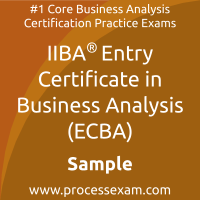01. You have documented stakeholder needs, but a requirement for a new feature remains unclear. What should you do NEXT?
a) Submit the ambiguous requirement to the approval team for further clarification.
b) Collaborate with the stakeholder to refine and confirm the ambiguous requirement.
c) Consult the development team to determine the technical feasibility of the requirement.
d) Remove the unclear requirement from the documentation to avoid confusion.
02. A business analysis professional is reviewing a company’s existing order management system before recommending changes. What is the primary objective of analyzing the current state?
a) Understand stakeholder workflows, processes, and systems to identify impacted areas.
b) Identify managers who will interact with the proposed changes when the system has been implemented.
c) Develop a prototype for testing the future system design before implementation.
d) Create a risk management strategy, risk plan, and risk matrix for challenges during implementation.
03. During a change implementation, you observe a delay in meeting milestones. Which action is MOST appropriate?
a) Escalate the issue immediately to senior management and suggest a resolution.
b) Inform customers about the delay and seek their input on alternative approaches.
c) Adjust the plan and communicate updated timelines to stakeholders.
d) Postpone further monitoring activities until the next milestone review is scheduled.
04. Your organization’s policy limits access to certain external tools that could streamline project activities. How can you maximize efficiency while adhering to the policy?
a) Implement the tool into the project knowing it will address the needs of your stakeholders.
b) Identify alternative tools or processes that comply with organizational policies.
c) Proceed without using the tool, documenting the potential inefficiencies caused.
d) Pause the initiative until the policy is reviewed and possibly updated.
05. Which of the following BEST communicates the value of a new solution to stakeholders?
a) A detailed report justifying the 40 work hours and resources invested in the project
b) A breakdown of implementation timelines to show how the solution meets deadlines
c) A comprehensive list of technical specifications and features of the solution
d) A presentation showing how the solution will reduce costs by 20% and increase efficiency
06. A stakeholder requests a feature that exceeds the initiative budget and timeline constraints. What is the MOST appropriate response?
a) Approve the feature and request additional funding from the management team.
b) Reject the feature, as it cannot be accommodated within the current scope.
c) Assess the feature’s feasibility and recommend a viable alternative solution.
d) Deprioritize the feature but include it in future project considerations.
07. You are exploring the use of an emerging technology for a new initiative. What is the FIRST step you should take?
a) Conduct a risk-benefit analysis to determine the technology’s relevance and implications.
b) Develop a prototype using the new technology to validate its potential benefits.
c) Consult senior leadership to gather their support for adopting the technology.
d) Have development set up a sandbox environment so that you can test the technology safely.
08. During user acceptance testing (UAT), a key feature does not function as expected. What is the FIRST step you should take?
a) Halt all testing activities so you can focus on resolving the issue.
b) Document the issue and discuss next steps with the implementation team.
c) Escalate the problem to senior management for their input on the resolution.
d) Continue testing other features and add the non-functioning feature to the risk register.
09. You are tasked with analyzing why a recently implemented process is underperforming. Which factor should you consider FIRST?
a) The tools and resources available to support the process’s success, including software systems and training programs
b) The external environmental conditions influencing organizational operations, including market trends and competitor offerings
c) Stakeholder attitudes and perceptions about the change, including resistance or lack of engagement
d) The alignment of the process with organizational strategy, including business objectives and strategic outcomes
10. A stakeholder struggles to articulate their needs during a workshop. How should you approach this situation?
a) Suggest potential solutions that align with broader industry best practices.
b) Conduct a follow-up interview that uses targeted and clarifying questions.
c) Focus on capturing the needs the stakeholder is comfortable expressing.
d) Ask other stakeholders to provide their perspective on the stakeholder’s needs.
 You have to pass the ECBA exam to receive the certification from IIBA. To increase the effectiveness of your study and make you familiar with the actual exam pattern, we have prepared this IIBA Business Analysis Entry sample questions. Our Sample IIBA Entry Certificate in Business Analysis Practice Exam will give you more insight about both the type and the difficulty level of the questions on the IIBA Business Analysis Entry Certificate exam.
You have to pass the ECBA exam to receive the certification from IIBA. To increase the effectiveness of your study and make you familiar with the actual exam pattern, we have prepared this IIBA Business Analysis Entry sample questions. Our Sample IIBA Entry Certificate in Business Analysis Practice Exam will give you more insight about both the type and the difficulty level of the questions on the IIBA Business Analysis Entry Certificate exam.